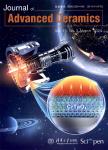Tribological behaviour of C/C-SiC composites-A review
Tribological behaviour of C/C-SiC composites-A review作者机构:Department of Mechanical Engineering Indian Institute of Technology(BHU) Varanasi-221005 India
出 版 物:《Journal of Advanced Ceramics》 (先进陶瓷(英文))
年 卷 期:2016年第5卷第1期
页 面:1-12页
核心收录:
学科分类:0808[工学-电气工程] 0809[工学-电子科学与技术(可授工学、理学学位)] 0817[工学-化学工程与技术] 0805[工学-材料科学与工程(可授工学、理学学位)] 0702[理学-物理学]
主 题:carbon-carbon (C/C) composites coefficient of friction wear
摘 要:Ceramic matrix composites made of carbon fibres and carbon matrix (C/C) are generally used for aircraft structures and brake discs due to their low density, and good thermal, mechanical, and tribological properties. Silicon carbide (SiC) can be introduced to the matrix to improve the performance of C/C composites, because it increases the hardness and thermal stability, and decreases the chemical reactivity, which leads to the improvement of tribological properties of C/C composites. Thus carbon–carbon silicon carbide (C/C–SiC) composites can be used at high temperature for the application of brake discs, friction clutches, etc. C/C–SiC composites are fabricated by three different methods: (i) chemical vapour infiltration (CVI), (ii) polymer infiltration and pyrolysis (PIP), and (iii) liquid silicon infiltration (LSI), among which LSI method is widely used for the fabrication of C/C–SiC composites due to higher mechanical and thermal properties.



